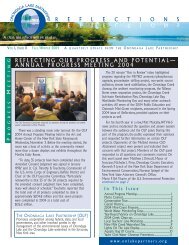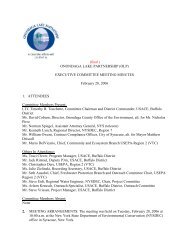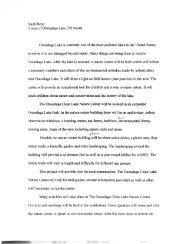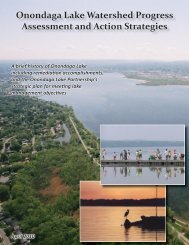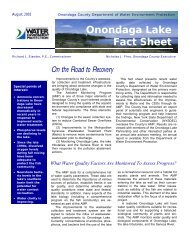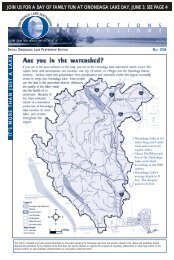Habitat Plan 2 - Onondaga Lake Partnership
Habitat Plan 2 - Onondaga Lake Partnership
Habitat Plan 2 - Onondaga Lake Partnership
Create successful ePaper yourself
Turn your PDF publications into a flip-book with our unique Google optimized e-Paper software.
DRAFTNorthern Water SnakeMudpuppies are a representative speciesin this <strong>Habitat</strong> <strong>Plan</strong>.Ospreys are representativespecies in this <strong>Habitat</strong> <strong>Plan</strong>.Common mudpuppy (Necturus maculosus) may be of interest since itinhabits large bodies of water; however, the NYS Herpetological Atlashas no records of the mudpuppy from either the Camillus or SyracuseWest USGS quadrangles. Mudpuppies have been reported from acluster of nearby quadrangles, specifically Manlius, Cleveland, Cicero,Mallory and Panther <strong>Lake</strong>. Of the toads and frogs listed, any or all ofthem might be found in the emergent wetlands, side sloughs, or smallisolated water bodies surrounding the lake. Of the turtles on the list,eastern snapping turtle (Chelydra s. serpentina) and eastern paintedturtle (Chrysemys p. picta) have been seen in the lake. Red-belliedcooter (Pseudemys rubiventris), a species introduced by release of pets,is a possibility in such an urban setting. Snake species that are possibleinhabitants of the shoreline of <strong>Onondaga</strong> <strong>Lake</strong> include the northernwater snake (Nerodia s. sipedon), which feeds in part on small fish.More terrestrial species that could be found in drier areas along theshoreline include common garter snake (Thamnophis sirtalis), easternmilk snake (Lampropeltis t. triangulum), and northern brown snake(Storeria d. dekayi). Eastern milk snakes have been reported by fieldpersonnel on Wastebed B and northern brown snakes were reported onWastebeds 1-8. All of these species are common and are fairly tolerantof urbanization. See Appendix A for a complete list of species from theNYS Herpetological Atlas data for the lake vicinity.2.4.6 Birds<strong>Onondaga</strong> <strong>Lake</strong> is within the Atlantic flyway and provides a variety ofhabitats for bird species. <strong>Onondaga</strong> <strong>Lake</strong> is recognized as an ImportantBird Area (IBA) because of its value as a congregation area forwaterfowl. The IBA program is an international bird conservationinitiative with simple goals: to identify the most important places forbirds, and to conserve them. IBAs are identified according tostandardized, scientific criteria through a collaborative effort amongstate, national, and international non-governmental conservationorganizations, state and federal government agencies, localconservation groups, academics, grassroots environmentalists, andbirders. As a result, IBAs link global and continental bird conservationpriorities to local sites that provide critical habitat for native birdpopulations. Currently, IBA programs exist in 130 countries around theworld, including 21 countries in the Americas.The <strong>Onondaga</strong> <strong>Lake</strong> BERA (TAMS, 2002b) documents that over 30species of birds and 13 species of waterfowl have been observedaround the lake. Much of the data presented in the BERA was basedon the Breeding Bird Atlas of 2000. This comprehensive, state-widesurvey of birds was updated in 2005, and identified over 80 species ofbirds/waterfowl frequenting the lake area (Appendix B). Some of themore common bird species include red-tailed hawk (Buteo jamaicensis),red-winged blackbird (Agelaius phoeniceus), mourning dove (Zenaidamacroura), killdeer (Charadrius vociferous), blue jay (Cyanocittacristata), barn swallow (Hirunda rustica) and ring-billed gull (Larusdelawarenis). Common waterfowl species include Canada goose(Branta canadensis), wood duck (Aix sponsa), mallard, and commonmerganser (Mergus merganser).PARSONS | Remedial Design Elements for <strong>Habitat</strong> Restoration 67



